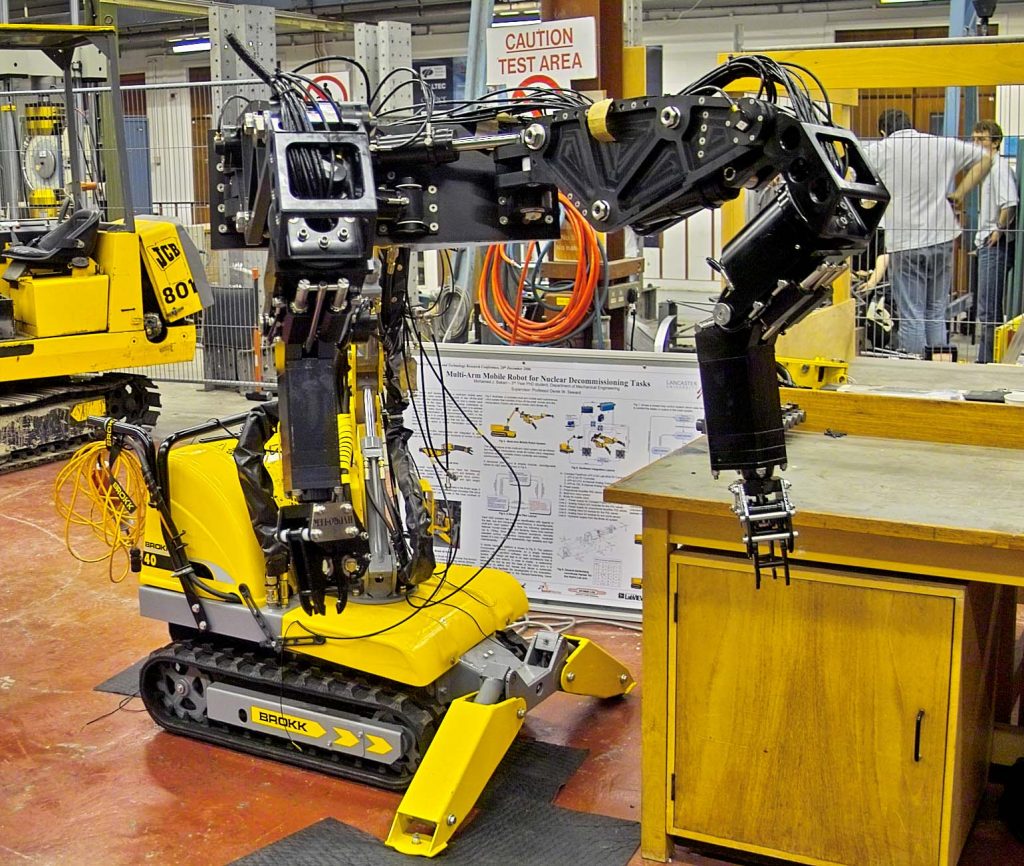Funding: NNL-NDA, £83k, 2010–2012
Investigator: Professor C J Taylor (PI)
This project will develop widely applicable control architectures for off-the-shelf robotic platforms with nonlinear actuators, which are essential to nuclear decommissioning challenges in the UK.
Where the use of people in areas of significant contamination is not possible, it is often necessary to resort to the use of remote and teleoperated robotic solutions. These provide an invaluable option for the safe retrieval and disposal of contaminated materials in high-hazard legacy facilities, whilst safeguarding the environment and minimising radiation exposure to operators. In the early stages of clean-up, expensive, bespoke machines were designed, built and commissioned. However, these were rarely transferable to other challenges. More recently, off-the-shelf remote solutions are strived for but these suffer from a converse restriction: they lack the ease of control afforded by high-specification bespoke solutions.
This project aims to alleviate this unsatisfactory situation by affording optimized, widely applicable control architectures that will be developed and tested on an off-the-shelf mobile robotic platform, with a particular focus on the coordinated control of its dual-arm manipulators. These potentially have many advantages over single-arm robots because they introduce additional flexibility to, for example, generic cutting operations, whilst not risking the enormous expense of bespoke robotic design.
Whether the device is controlled autonomously, semi-automatically or by remote control, the use of dual arms introduces substantial additional complexity to the problem. Consider, for example, the case that the two robot arms are attempting to align two held objects. Here, the first problem is to co-operatively control the arms in position or force, in order to line up the objects. However, when the two arms work together simultaneously for a common goal, this introduces a second problem: there is an increased probability that their geometrical closeness will lead to collisions between their links. Collision-free trajectory planning is an exciting and large domain in robotics. It covers many different subjects, such as global path planning, trajectory optimization, collision detection and collision avoidance.
The project will utilise a BROKK 40 decommissioning robot, consisting of a moving vehicle with a single five degree of freedom manipulator, hydraulic tank and remote control device. The multi-arm system attached to the BROKK 40 is the Hydro-Lek HLK-7W, which takes the form of two seven-function manipulators, i.e. six rotary joints and a gripper.
Combined with rapid advances in animatronics in recent years, such dual arm mobile robots now offer a powerful tool for various types of decommissioning activity: for example, a glove box approach will allow operators to manipulate objects remotely. Unfortunately, devices initially developed for heavy lifting are not necessarily suitable for ‘soft touch’ duties such as picking up relatively fragile objects. Indeed, the manipulator above can suffer from a relatively slow and imprecise control action because of limitations in the existing feedback algorithms.
The project will build on earlier research at Lancaster University into advanced control using state dependent parameter models. Any inherent nonlinearities in the system are accounted for using full (non-minimal) state variable feedback methods: see illustrative publications below. Here, the control parameters are functionally dependent on the measured state variables. Since the behaviour of hydraulically-driven manipulators is dominated by the nonlinear, lightly-damped dynamics of the actuators, the approach offers a timely and powerful new tool for control system design. The proposed research will exploit these preliminary results to develop a modular approach for feedback control and intelligent decision making of nonlinear hydraulic actuators, so as to reduce the time and cost of developing bespoke robotic solutions.
